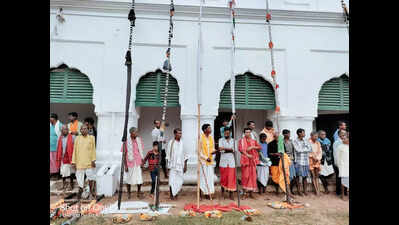ARTICLE AD BOX

The tribal groups will bring their traditional sacred bamboos to Jeypore during the puja, a ritual started by the Jayapura kingdom and in practice for over 300 years
Koraput: Over 60 tribal groups are expected to participate in this year’s festivities organised by the Jeypore Dussehra Puja Committee. “This year, invitations will be sent to over 60 groups from across the district to participate in the festival,” Jeypore MLA Tara Prasad Bahinipati, who heads the committee, said.A preparatory meeting was held on Saturday to finalise the arrangements for the upcoming festival, which remains a key event in the cultural calendar of Jeypore.The participating tribal groups will bring their traditional ‘lathis’ or sacred bamboos to Jeypore during the puja, a ritual started by the Jayapura kingdom and in practice for over 300 years. The sacred bamboos are kept in village altars throughout the year to ensure prosperity and form an integral part of the Dussehra ceremonies.Once a grand affair during the reign of kings, the royal traditions of Dussehra in Jeypore continue to be celebrated, albeit with diminished grandeur. The town, known for its rich history and the cultural prominence of the Jayapura kingdom, still witnesses the participation of various tribal groups during the festivities.In the past, the Dussehra celebrations in Jeypore were a 16-day extravaganza, rivalling the opulence and scale of the famous Mysore Dussehra.
“The grandeur with which Dussehra was celebrated during the time of the kings was extraordinary,” Jeypore-based tribal researcher Paresh Rath, said. “However, after the abolition of the zamindari system, the celebrations began to lose their splendor and tribal participation started to decline,” he added.Historically, the king of Jeypore would lead the Dussehra festivities, beginning with a special ritual at the Kanak Durga temple.
The king, adorned in royal attire, would ride a decorated elephant through the town, followed by a grand procession of village headmen carrying their sacred lathis. The march culminated at the Dussehra field, where a yagna (sacred fire ritual) was performed and cattle was sacrificed in what was known as Aparajita or Durga Puja.The village headmen, known as ‘pujharis’, acted as both priests and tax collectors. They would offer the revenue and gifts collected from their villages to the king during Dussehra, in exchange for the redressal of their grievances and concerns.Tribal groups, including the Bhumiya, Gadva, Parja, Soura, Bhatra, Gond, Didai, Durua, Kondh, Bonda and Koya, would trek barefoot to Jeypore, sometimes traveling for over a month across hilly terrain. They carried idols of goddess Durga in palanquins and played traditional musical instruments as they journeyed.While the king no longer leads the celebrations, the sacred bamboos continue to be honored and efforts are underway to revitalise the ancient festival.



.png)
.png)
.png)
















 2 hours ago
3
2 hours ago
3









 English (US) ·
English (US) ·